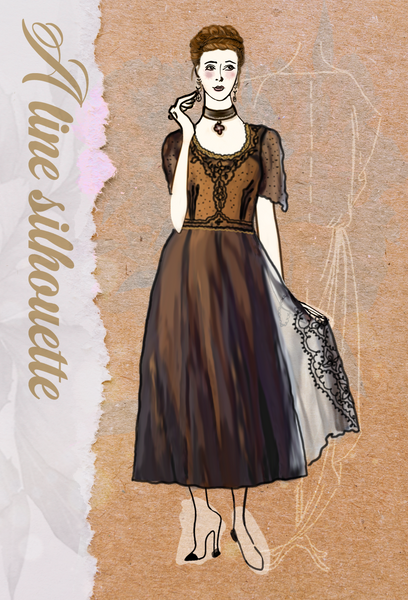Get a timeless, elegant look with a figure-flattering A-Line Silhouette
A-Line Silhouette
There is perhaps no silhouette that is easier for a woman to wear than an A-line silhouette. A-line dresses enhance a woman’s natural hourglass shape and make her look undeniably feminine. Ideal for virtually any body type, it’s obvious why this type of dress has withstood the test of time and maintains universal appeal among women everywhere.
Characteristics
As the name suggests, A-line dresses have a skirt that mimics the look of a capital letter “A”. Garments that figure an A-line silhouette often have a defined seam that is designed to hit a woman at her natural waist, highlighting the smallest part of her body. These types of dresses also typically have an inherent sense of structure in the bodice, which further enhances a woman’s feminine hourglass and creates an elegant, ideal shape.
Origins
A-line dresses (which are sometimes referred to as “ballgown” style dresses) are not a new concept. They first rose to popularity in the 1800s during the Victorian Era. Corsetry was incredibly prevalent during this time period, and women showcased their tiny waistlines by wearing dresses that highlighted this area of their body.
Victorian A-line dresses often came complete with a structured bodice and a billowing skirt. The result was a dramatic hourglass silhouette that was heavily exaggerated by the shape of the dress. Quite ladylike in design, dresses from this era are decadent and distinct. Often, they are used to reference what upper-class women wore during the Civil War and Antebellum period of American history.

The A-line silhouette once again came into its own during the 1950s. Dior’s famous “New Look” collection was characterized by garments that nipped the waistline and were accompanied by a full, pleated skirt. Revolutionary at the time, Dior’s incredible take on women’s clothing soon became the "most wanted silhouette in Paris" after it debuted in 1955. Women everywhere in the 1950s wanted an inherently feminine silhouette, and A-line dresses quickly became a wardrobe staple.
Not long after, other famous designers created clothing that mimicked this highly sought-after silhouette. In 1958, Yves Saint Laurent created “trapeze dresses,” which are a slightly more dramatic take on this classic design. The trapeze silhouette - which also features a flared skirt with an “A” shape - brought this trend into the 1960s as well.
A Modern Take on a Classic Silhouette
The Nataya Alice 40815 dress is the perfect example of the timelessness of an A-line cut. It pairs a seam that hits at a woman’s natural waistline with a flowing tulle skirt. The result is an updated take on an A-line silhouette that still manages to reference the past thanks to its decadent fabrics and elegant aesthetic.
The A-line remains popular century after century. The reason is simple - this figure-flattering silhouette has the ability to accentuate body parts you might like to show off and hides whatever you like to keep hidden. Therefore, it is always alluring and inherently feminine on absolutely any figure.


Leave a comment